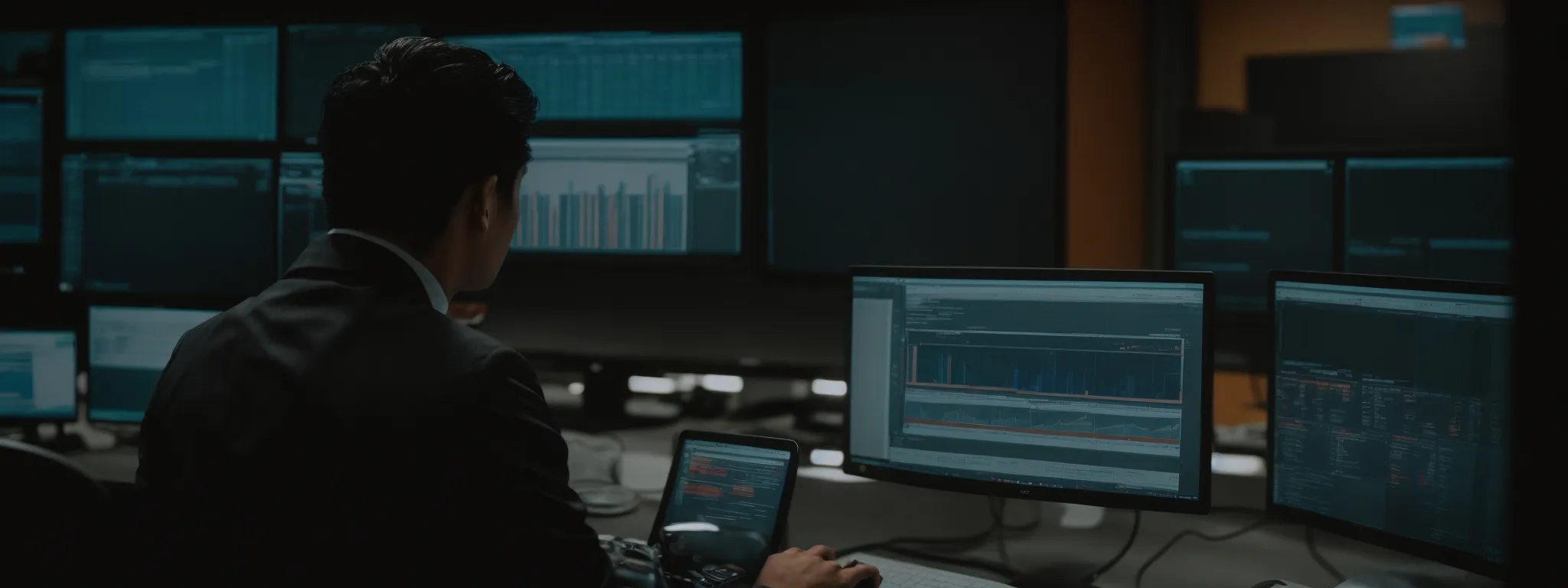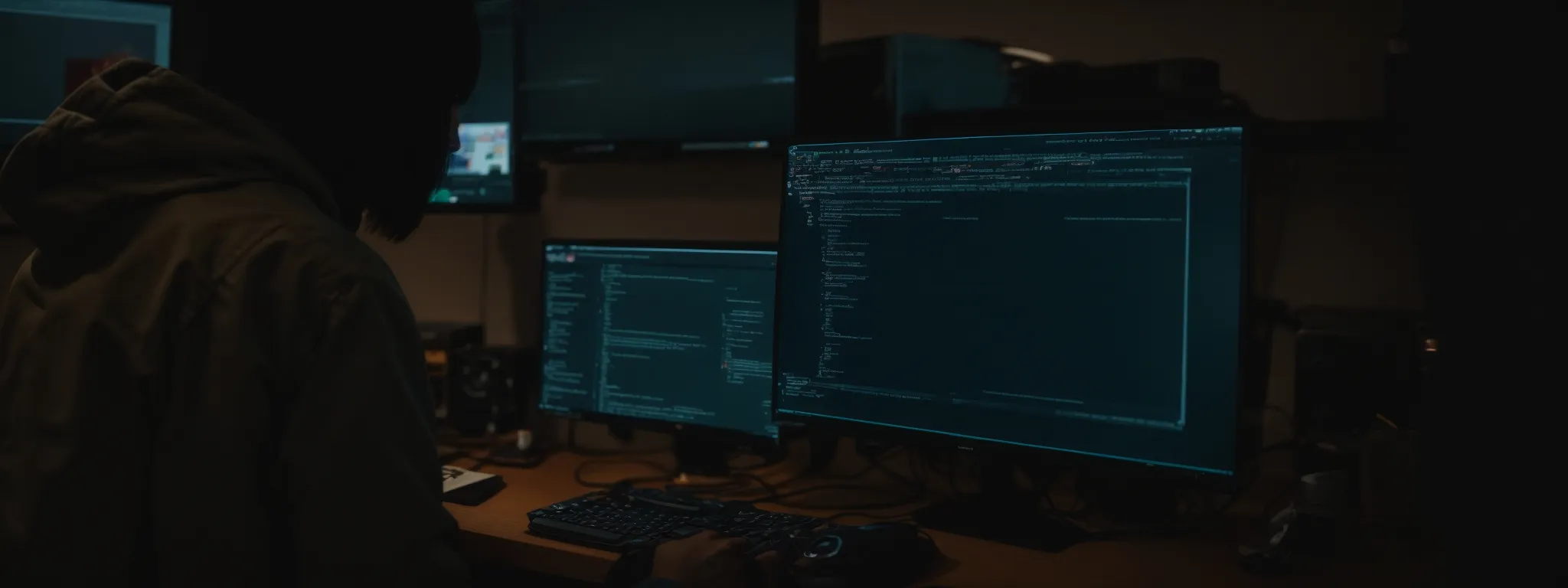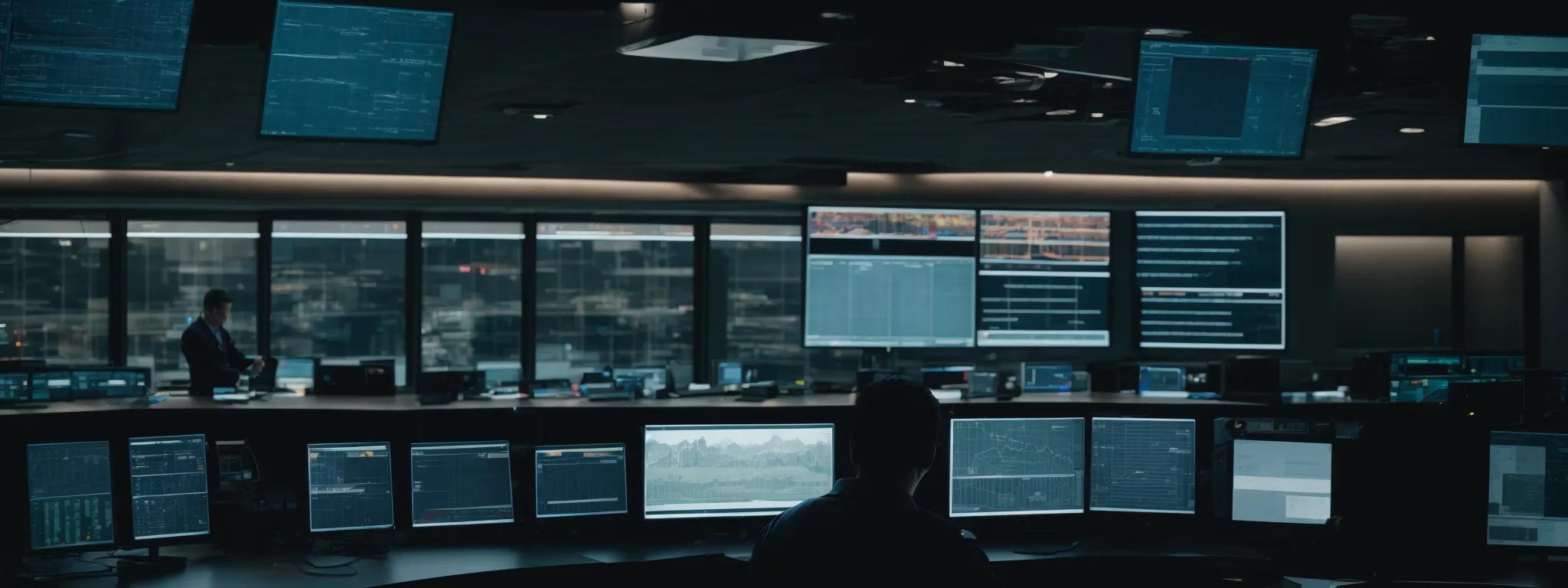Recovering from a Google Penalty: Essential Steps
Navigating Google Penalty Recovery: Essential Steps for Success When a website is hit by a Google penalty, the repercussions on search visibility and search traffic can be […]
When a website is hit by a Google penalty, the repercussions on search visibility and search traffic can be severe, turning once-bustling pages into digital ghost towns.
LinkGraph’s SEO services understand the gravity of such penalties and their impact on a company’s online presence.
Site owners must act swiftly and proficiently to diagnose the problem, clean the backlink profile, enhance content standards, and adhere to the stringent quality guidelines laid down by search engines.
LinkGraph’s expert recovery process offers a path to salvation for businesses caught in the unforgiving tide of algorithm updates and manual actions.
Keep reading to discover how to implement a robust recovery strategy and regain favor with search engines.
Key Takeaways
- Understanding the Type of Google Penalty, Whether Manual or Algorithmic, Is Critical for Creating a Successful Recovery Strategy
- A Site Audit Using SEO Tools Like SearchAtlas Is Essential to Identify on-Page and Off-Page Issues Contributing to the Penalty
- Removing Harmful Backlinks and Utilizing Google’s Disavow Tool Are Significant Steps in the Penalty Recovery Process
- High-Quality, Valuable Content Aligned With Google’s E-a-T Principles Is Key to Recovery and Long-Term Search Engine Success
- Ongoing Education and Monitoring of SEO Best Practices and Guidelines Are Vital to Avoid Future Penalties and Maintain Search Rankings
Understanding the Type of Google Penalty Affecting You

Embarking on the journey to resolve a Google penalty requires a clear understanding of the infringement that caused the downturn in search rankings.
A pivotal first step for businesses is to distinguish whether the search engine’s punitive measures are the result of manual actions by human reviewers or algorithmic updates.
Vigilance in monitoring Google Search Console emerges as indispensable, as it is often the first place where notifications about such penalties appear.
Comprehension is crucial at this juncture; site owners must discern the intricacies of algorithmic changes and grasp their extensive impacts.
This groundwork lays the foundation for an effective recovery plan, tailored to address the specific nature of the penalty and restore a website’s search traffic to its rightful potential.
Differentiating Manual Actions From Algorithmic Penalties
Site owners must navigate the recovery process with precision, first identifying whether a manual action or an algorithmic penalty is the culprit behind their SEO woes. Manual actions involve a human reviewer from Google’s team who has manually flagged the site for not adhering to quality guidelines, while an algorithmic penalty automatically arises from updates to Google’s search algorithm that devalue certain SEO tactics.
Algorithmic changes often go unnoticed until a noticeable drop in search visibility occurs, whereas manual actions come with an explicit notification through Google Search Console. Success in recovery hinges on understanding these distinctions, as each type of penalty demands a unique response strategy to realign with Google’s webmaster guidelines and restore search traffic.
Analyzing Google Search Console for Penalty Notifications
When a site experiences a decline in search performance, careful examination of the Google Search Console is critical for identifying any penalties. It acts as a barometer by flagging issues through notifications, guiding site owners toward understanding the specific penalty, be it a manual action or an algorithm update that requires attention.
For a business to respond appropriately, these notifications require meticulous analysis. They offer detailed information on the nature of the penalty, thereby enabling the site owner to devise a focused remediation strategy. These insights are integral to the subsequent steps of the recovery process, as they set the stage for targeted corrective measures that align with Google’s search quality standards.
Identifying Algorithmic Changes and Their Impact
Ascertaining the root cause of a downturn in search rankings often points to the implementation of an algorithm update. These updates, such as the notorious Google Penguin, dynamically alter the search landscape, inadvertently ensnaring websites that fail to adapt their SEO strategies to the evolving criteria.
When site owners detect fluctuations in search visibility, it’s imperative to cross-reference these shifts with the timeline of known algorithm changes. Acknowledging the interconnectedness between an update and search rankings allows for a recalibration of SEO techniques, ensuring they fall within the refined parameters of Google’s search algorithm.
Performing a Comprehensive Site Audit to Uncover Issues

The path toward recovering from a Google penalty is seldom straightforward and invariably commences with an exhaustive audit of the affected website.
Such a meticulous evaluation, leveraging potent SEO tools, is instrumental for Unveiling the Extent of on-Page and off-page issues that may have prompted the search engine’s punitive actions.
This thorough analysis is vital in unearthing not only the conspicuous fractures in a site’s SEO fabric but also in identifying subtler red flags commonly associated with penalization.
Emphasizing the critical areas that warrant immediate attention, an effective site audit serves as the linchpin in the strategic blueprint for redemption in the eyes of the world’s premier search engine.
Utilizing SEO Tools for a Full Site Analysis
To navigate through the intricacies of Google penalty recovery, it is paramount for businesses to start with SEO tools capable of dissecting their website’s current SEO health. SearchAtlas SEO software, for instance, provides a comprehensive suite of tools that dives deep into on-page factors, backlink profiles, and content quality, facilitating the detection of issues that may contravene Google’s quality guidelines.
| SEO Factor | Tool Feature | Penalty Risk Assessment |
|---|---|---|
| On-Page Elements | SearchAtlas’ On-Page Analyzer | Checks for over-optimization, poor content practices |
| Backlink Profile | Free Backlink Analysis | Evaluates quality, relevancy, and spam indicators |
| Content Quality | Content Audit Features | Identifies thin or duplicate content, keyword stuffing |
Armed with such precise diagnostics from the full site analysis, LinkGraph’s SEO services can generate an actionable SEO audit: pinpointing the adjustments needed for penalty recovery and future risk mitigation. A transparent view of the website’s backlinks, content, and on-page elements aids site owners in understanding their current search rankings impact and guides reformative strategies for improved search visibility.
Highlighting Major on-Page and Off-Page Issues
Addressing on-page issues constitutes a critical aspect of rectifying a website’s standing with Google. Through LinkGraph’s on-page SEO services, experts meticulously examine aspects such as meta tags, header tags, and keyword usage to ensure they reflect best practices and abide by search engine guidelines, evading triggers for penalties.
Conversely, off-page issues primarily revolve around a website’s backlink profile, where white-label link building services offer solutions tailored to ameliorate harmful links and bolster beneficial ones. This focused attention to external linking strategies is paramount, considering their significant influence on a site’s authority and search engine rankings.
Checking for Common Penalization Red Flags
In the attempt to regain search engine favor, meticulous attention to common penalization red flags becomes indispensable. Site owners must scrutinize their web pages for any signs of black-hat techniques such as cloaking, the use of doorway pages, or hidden text and links: all classic triggers for penalties.
LinkGraph’s SEO services take a proactive approach in screening for punitive measures related to content practices. These include the overuse of target keywords, often referred to as keyword stuffing, and the presence of “spammy” content or links that degrade the user’s experience and violate Google’s stringent quality guidelines:
- Intensive review of keyword density to prevent over-optimization
- Examination of link quality to root out spammy or irrelevant backlinks
- Content analysis to detect and remedy duplication or thin content
Addressing Unnatural or Spammy Backlinks

In the realm of search engine optimization, a pristine backlink profile is paramount to maintaining high search visibility and authority.
LinkGraph, an adept SEO company, recognizes that unnatural or spammy backlinks can severely derail a website’s standing in Google search results.
Tackling this aspect head-on is essential when a business falls victim to a Google penalty, necessitating a meticulous backlink profile review.
This critical stage involves a thorough analysis to distinguish detrimental links, the initiation of efforts to remove them, and as a final resort, the submission of a disavow file to Google.
Each action taken is rigorously documented to support the recovery service’s advocacy for a site’s reconsideration by the search engine.
Conducting a Backlink Profile Review
Initiating the recovery service for a website begins with a painstaking examination of the backlink profile. LinkGraph’s experts deploy state-of-the-art SEO tools from their SearchAtlas SEO software suite to sift through and evaluate each link, determining its relevancy and quality, thereby identifying those that damage the site’s credibility in the eyes of Google.
During this meticulous process, LinkGraph’s SEO services hone in on the backlink details, flagging any that exhibit traits of being unnatural or spammy. The outcome of this assessment is critical, as it informs the necessary steps for link removal or disavowal to realign the website with the stringent standards set forth by search algorithms.
Removing Harmful Links and Documenting Efforts
Upon isolating harmful links within a backlink profile, a meticulous removal process commences. LinkGraph’s SEO experts engage directly with webmasters to request the excision of these detrimental links, ensuring each outreach effort is meticulously chronicled to provide a transparent record for Google’s reconsideration request.
Should removal requests not yield the desired response, documentation of these endeavors becomes a crucial element in demonstrating proactive steps taken. It substantiates the necessity of disavowing links, supporting the formal submission to Google and further reinforcing the recovery service’s commitment to reestablish the website’s integrity within search rankings.
Submitting a Disavow File to Google
Once the process of link removal reaches its limit, LinkGraph’s adept team turns to the creation of a disavow file: a conclusive measure communicated directly to Google. This file articulates which links the site owner believes are harmful and requests Google to disregard them in evaluating the site’s quality.
Submitting this file via Google’s Disavow Tool indicates to the search engine that the site owner has made every reasonable effort to clean the backlink profile and signals a commitment to adhering to Google’s quality standards. It’s a critical step, often serving as the final defense in rectifying a penalty and safeguarding against future search visibility issues.
| Action Step | Purpose | Outcome for Recovery |
|---|---|---|
| Link Removal Requests | To eliminate harmful backlinks | Decreases the number of spammy links |
| Disavow File Creation | To communicate non-removable spammy links to Google | Tells Google to ignore specific links when assessing the site |
Improving Content Quality Across Your Website

In the wake of a Google penalty, revitalizing content quality emerges as a cornerstone in reclaiming search engine esteem.
High-caliber content resonates with both the algorithm’s predilections and the user’s quest for valuable information.
A thorough combing through website material to flag and fortify thin or duplicated passages lays the groundwork.
Additionally, infusing content with added value and ensuring alignment with Google’s Expertise, Authoritativeness, and Trustworthiness (E-a-T) principles comprise tactical steps in the overarching SEO strategy.
These actions embody proactive measures essential not only for penalty recovery but also for establishing a robust foundation for enduring search engine optimization success.
Identifying and Enhancing Thin or Duplicate Content
Revitalizing a website’s content commences with identifying pages that suffer from thin content or duplicate passages. LinkGraph’s experts scrutinize each web page, leveraging advanced SEO tools to Detect Low-Quality Content that could be dampening the site’s search engine performance.
Once problematic content is identified, LinkGraph’s content creation services work diligently to enhance and revamp these areas. An emphasis on providing rich, informative, and original content ensures each webpage contributes positively to the overall health of the site and meets the rigorous expectations of Google’s search algorithm:
| Content Issue | LinkGraph’s SEO Solution | Anticipated SEO Benefit |
|---|---|---|
| Thin Content | Expansion and Enrichment | Increased depth and value of web pages |
| Duplicate Content | Original Content Creation | Unique pages enhancing the site’s uniqueness |
Implementing Strategies for Adding Value Through Content
LinkGraph’s SEO services prioritize enriching website content to surpass mere recovery, aiming for a substantial leap in search engine value. This progression entails tailoring content that furnishes users with comprehensive, actionable insights, thereby enhancing the user experience and amplifying engagement metrics that search engines favor.
To infuse web pages with additional substance, experts at LinkGraph formulate a robust SEO content strategy that targets core subject areas, weaving in relevancy and depth. They initiate editorial calendars to ensure consistency in high-quality content delivery and capitalize on advanced SEO tools to refine keyword integration, amplifying the relevance of content to target keyword searches:
- Formulation of an informed SEO content strategy.
- Development of an editorial calendar for sustained content quality.
- Utilization of advanced keyword integration methods.
Aligning Content With Google’s E-a-T Principles
LinkGraph’s meticulous approach ensures content is not only informative but also exudes credibility, directly aligning with Google’s E-A-T (Expertise, Authoritativeness, Trustworthiness) principles. The agency’s experts enhance the authority of the web content by promoting subject matter expertise, author credentials, and factual accuracy to build trust with both users and the search algorithm.
Through strategic revisions, LinkGraph’s content creators elevate each piece to meet the stringent expectations of Google’s quality guidelines, focusing on reliability and relevance. By prioritizing these elements, content transcends beyond mere attractiveness, becoming a powerful asset in recovering and sustaining improved search engine rankings.
Fixing Technical and on-Page SEO Problems

Navigating the complex landscape of Google penalty recovery demands a multifaceted approach, with a critical focus on rectifying technical SEO issues and optimizing on-page elements.
Site owners need to resolve crawling errors and ensure proper indexing to allow search engines to access and catalogue content effectively.
Similarly, fine-tuning page titles, descriptions, and headers is essential to communicate relevance and intent to search algorithms—aligning with user queries and expectations.
Moreover, enhancing site speed and mobile usability is paramount in fostering a seamless user experience, a factor increasingly weighted by Google.
Each of these technical and on-page optimizations bears considerable weight in the penalty recovery process, underscoring their pivotal roles in reestablishing a website’s standing in search results.
Correcting Crawl Errors and Indexing Issues
Ensuring that a website is accessible and properly indexed by search engines is imperative as part of the recovery from a Google penalty. LinkGraph’s on-page SEO services meticulously address crawl errors and indexing problems, establishing a solid foundation for bots to traverse and evaluate the site effectively.
With the assistance of SearchAtlas SEO software technology, LinkGraph’s experts systematically rectify technical roadblocks, allowing Google’s algorithms to seamlessly index web content. This correction process is crucial for restoring a website’s visibility and reinstating its position in the search rankings.
Optimizing Page Titles, Descriptions, and Headers
Optimal configuration of page titles, descriptions, and headers is vital to the fabric of on-page SEO, serving as signposts for search engines to discern the thematic thrust of a web page. LinkGraph’s on-page SEO services meticulously calibrate these elements to mirror the search intent of target keywords, ensuring web pages are primed for better placement in Google search results.
Concise, compelling page titles and meta descriptions are crafted to increase click-through rates from search engine result pages (SERPs), while header tags are structured to provide a clear, organized content hierarchy. This strategic arrangement aids search algorithms in understanding the content’s relevance, elevating the site’s authority and relevance concerning user queries.
Increasing Site Speed and Mobile Usability
Embarking on a quest to boost a website’s recovery from a Google penalty, LinkGraph’s SEO experts emphasize the importance of increasing site speed and optimizing for mobile usability. These facets are crucial as they significantly affect user experience—a paramount criterion in Google’s ranking factors—and play a pivotal role in the website’s recovery trajectory.
LinkGraph leverages technical SEO expertise to enhance website performance, ensuring fast load times which are essential for retaining visitor engagement and reducing bounce rates. Simultaneously, their precise optimization protocols adapt websites to the mobile-first index, recognizing that the ubiquity of smartphone browsing necessitates an impeccable mobile user experience for sustainable search engine favor and position restoration.
Submitting a Reconsideration Request the Right Way

In the intricate labyrinth of reclaiming a website’s favor in Google’s algorithmic gaze, one decisive maneuver stands as the apex of the effort: submitting a reconsideration request to the search engine’s discerning eyes.
This capstone action in penalty recovery encompasses crafting a genuine and comprehensive letter that chronicles the website’s transgressions and the remedial steps undertaken to align with Google’s esteemed webmaster guidelines.
Mastery over this delicate process is quintessential, as it not only demonstrates reformation but also anticipates the nuances of the review procedure, laying out a clear trajectory for regaining lost search standings.
Writing an Honest and Detailed Reconsideration Letter
Composition of a reconsideration request is pivotal, demanding both transparency and meticulous detail in recounting the website’s corrective journey. LinkGraph’s seasoned professionals guide site owners in preparing a compelling narrative that outlines the specific actions taken to comply with Google’s guidelines, ensuring the communication is not only forthright but corroborated with concrete evidence of the SEO improvements made.
In penning this request, the overarching goal is to convey a clear commitment to maintaining the integrity of the internet ecosystem, in line with Google’s ethos. Collaboration with LinkGraph’s SEO experts results in a letter that not only documents the resolved issues but also effectively communicates the measures implemented to prevent future infractions, strengthening the likelihood of a successful outcome with Google’s review team.
Showcasing Efforts and Changes Made to Comply With Guidelines
LinkGraph takes diligent strides to illuminate the exhaustive efforts and strategic changes executed to align with Google’s guidelines as part of the reconsideration process. The presentation of a detailed account to Google, showcasing the comprehensive audit conducted, the removal or disavowal of questionable backlinks, and the Enhancement of on-Page Content, showcases a deep commitment to quality standards and ethical SEO practices.
The company’s client-focused approach ensures that each step of the corrected actions is transparently mapped out and communicated with precision, leaving no stone unturned in demonstrating compliance. This meticulousness in highlighting the proactive recovery initiatives serves to underscore the site owner’s dedication to upholding the integrity of their site in Google’s search landscape.
Knowing What to Expect During the Review Process
During the reconsideration review process, LinkGraph’s experts underscore the importance of patience and an understanding of timing. The duration of the review by Google’s team can vary, as it involves a thorough examination of changes and data submitted to ascertain compliance with Google’s webmaster guidelines. Site owners should prepare for this stage with the awareness that a detailed review ensures a fair and comprehensive assessment of their efforts to rectify SEO practices.
Anticipating feedback from the review team is also an integral part of preparing for the reconsideration process. It’s not uncommon for additional actions to be requested, and Google may provide extra guidance on other areas needing attention. LinkGraph’s SEO services support businesses throughout this interactive phase, ensuring site owners are responsive, adaptive, and ready to implement any further amendments advised by Google’s team to achieve penalty recovery.
Staying Updated With Google’s Webmaster Guidelines

In the swiftly changing realm of search engine optimization, adherence to Google’s webmaster guidelines is not a matter of choice but a prerequisite for digital success.
To eschew further penalties and fortify their SEO framework, businesses must engage in a regimen of continuous learning and adaptability.
This requires a structured approach to assimilating Google’s frequent updates and best practices, which, when woven into the fabric of a company’s SEO strategies, safeguard the integrity and search standing of the website.
An unwavering commitment to educating the SEO team and preemptively monitoring the website’s performance for aberrations is essential to navigate through Google’s dynamic search landscape and maintain upward trajectory in search rankings.
Regularly Reviewing Google’s Updates and Best Practices
In the dynamic digital ecosystem, maintaining a keen eye on Google’s continuous stream of updates and best practices is indispensable for SEO longevity. LinkGraph’s SEO services champion this proactive approach, ensuring that clients’ strategies are perpetually refined in tune with the latest algorithmic nuances.
Site owners aligned with LinkGraph benefit from strategic insight into the ever-evolving landscape of search engine guidelines. Their SEO strategies stay resilient, adaptive, and poised to meet Google’s quality benchmarks:
- LinkGraph’s continuous analysis of algorithmic shifts equips websites to face changes head-on.
- Implementations of best practices are regularly updated, maintaining SEO relevance and efficacy.
- Staying aware of Google’s guidance ensures proactive avoidance of future penalties.
Educating Your Team on Compliance and Ongoing SEO Strategies
Ensuring team-wide compliance with Google’s webmaster guidelines is an ongoing endeavor that demands regular education and strategy updates. LinkGraph’s white label SEO services equip agencies with the knowledge and tools to disseminate best practices across their teams, fostering a culture of SEO compliance and strategic prowess.
| Focus Area | Education Strategy | Outcome |
|---|---|---|
| Webmaster Guidelines | Regular team training sessions | Consistent adherence to Google’s SEO standards |
| Algorithm Updates | Real-time updates and workshops | Agile response to search engine changes |
LinkGraph’s commitment to educating its clients extends beyond mere knowledge transfer: it empowers site owners and their teams to internalize and apply ongoing SEO strategies. By cultivating an informed and dynamic workforce, organizations are better prepared to navigate changes within the search landscape, ensuring continuity in enhancing search rankings and performance.
Monitoring Website Performance for Sudden Changes
Meticulous monitoring of a website’s performance is a crucial element in preemptively identifying signals of a Google penalty. Astute site owners, in collaboration with LinkGraph’s SEO services, ensure that unexpected dips in search rankings or traffic are quickly detected, enabling them to respond with agility to mitigate any adverse effects.
Through diligent use of advanced SEO tools and analytics, LinkGraph’s experts assist clients in interpreting data patterns that signify potential issues. This vigilant oversight allows for immediate investigation and action, circumventing protracted negative impacts on search visibility that can stem from Google’s algorithm updates or penalties.
Post-Penalty: Continuous Monitoring and Prevention

Surviving the perils of a Google penalty often leads to a sigh of relief for website owners, but the work doesn’t end there.
To secure their hard-won recovery and elevate their search rankings, it is critical for site owners to adopt a routine of regular audits and fine-tuning of their SEO approach.
This vigilance ensures that they stay ahead of search engine updates and adhere to organic search best practices.
Forward-thinking businesses must develop an SEO strategy that not only supports current success but is also sustainable for future growth.
By steadfastly committing to white hat techniques, companies can preempt potential penalties, thereby protecting their online presence and the valuable search authority they’ve rebuilt.
Implementing Regular Audits and Adjustments
In the wake of a Google penalty, the implementation of regular audits becomes a vital practice to ensure sustained search rankings stability. Through these assessments, LinkGraph’s SEO services help businesses identify and rectify any emergent issues before they escalate into punitive actions by search engines.
Adjustments to the SEO strategy are performed with precision, informed by data gleaned from ongoing audits, ensuring that a website’s optimization remains in lockstep with current search engine algorithms and user expectations. This proactive approach fosters resilience in search rankings, fortifying a site’s recovery achievements against future uncertainties.
Developing a Sustainable SEO Strategy Moving Forward
As businesses move beyond the hurdles of a Google penalty, it becomes imperative to craft an SEO strategy that’s not only robust but also future-proof. LinkGraph’s SEO services play a pivotal role in this process, helping clients construct a strategic framework that evolves with search engine advancements, ensuring sustainable growth and resilience against potential penalties.
With an emphasis on white label SEO services and data-driven decision-making, LinkGraph empowers site owners to build a far-reaching SEO blueprint. This strategic plan incorporates ongoing optimization, a commitment to quality content creation, and a keen focus on user experience, thereby aligning with the ever-changing landscape of Google’s search algorithms and best practices for enduring success in search rankings.
Embracing White Hat Techniques to Avoid Future Penalties
In the aftermath of a Google penalty, committing to white hat techniques becomes the cornerstone of preventative SEO maintenance. LinkGraph’s SEO services guide clients through the maze of establishing ethical and sustainable practices, which align with Google’s algorithms, ensuring the durability of their recovered search rankings.
By embracing white hat strategies, businesses under LinkGraph’s wing effectively fortify their defenses against future penalties. This approach involves not only adhering to search engine guidelines but also nurturing a glossary of SEO methodologies that prioritize user experience, high-quality content, and transparent backlink acquisition.
Conclusion
Successfully navigating Google penalty recovery is critical for restoring a website’s search engine rankings and credibility.
Recognizing whether the setback is due to a manual action or an algorithmic update is a crucial first step, followed by a detailed site audit using SEO tools.
Addressing both on-page and off-page issues is imperative, including tackling unnatural backlinks and enhancing content quality to realign with Google’s E-A-T principles.
Taking decisive actions such as removing harmful links, submitting a disavow file, and fixing technical and on-page SEO problems can significantly contribute to recovery efforts.
A well-crafted reconsideration request demonstrates the earnestness of the remediation to Google, and continuous education on webmaster guidelines protects against future penalties.
Post-recovery, maintaining regular website audits and adjustments ensures the sustainability of a website’s SEO strategy.
Embracing white hat techniques and a long-term SEO outlook is paramount.
This approach safeguards a website’s standing against future algorithmic changes and penalties, fostering enduring search engine optimization success.















































































